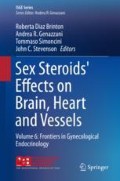Abstract
During menopausal transition, the ovaries are depleted of follicles, oestradiol and inhibin B production falls, and ovulation and menstruation no longer occur. The loss of ovarian sensitivity to follicle-stimulating hormone (FSH) and luteinizing hormone (LH) and the loss of negative feedback of oestradiol and inhibin B on the hypothalamic–pituitary unit result in increased production and release of gonadotropin release hormone (GnRH), FSH and LH. Increased FSH levels are particularly specific to postmenopause. Modifications of gonadotropins, oestradiol (E2), alterations in the function of noradrenergic and serotoninergic pathways and opioid tone in the hypothalamus cause the onset of vasomotor symptoms and consequent sleep disruption. Thermoregulatory dysfunction might be a result of a maladaptation of the brain to kisspeptin, neurokinin B and dynorphin (KNDy) neuron hypertrophy, which project to the preoptic thermoregulatory area. Mood, cognitive functions and neuroendocrine activity, which are closely related to the impairment of GABAergic, opioid and neurosteroid neurotransmitter milieu in the central nervous system (CNS), occur with climacteric period and during ageing. Failure of the main target of neurosteroids, the GABA-A receptor, to adapt to changes in levels of allopregnanolone over the course of the menopausal transition might lead to depressive symptoms, mood and cognitive dysfunctions.
Access this chapter
Tax calculation will be finalised at checkout
Purchases are for personal use only
References
Wise PM. Neuroendocrine modulation of the “menopause”: insights into the aging brain. Am J Phys. 1999;277(6 Pt 1):E965–70.
Downs JL, Wise PM. The role of the brain in female reproductive aging. Mol Cell Endocrinol. 2009;299(1):32–8.
Butler L, Santoro N. The reproductive endocrinology of the menopausal transition. Steroids. 2011;76(7):627–35.
Santoro N, Isaac B, Neal-Perry G, et al. Impaired folliculogenesis and ovulation in older reproductive aged women. J Clin Endocrinol Metab. 2003;88(11):5502–9.
Woods NF, Mitchell ES. Symptoms during the perimenopause: prevalence, severity, trajectory, and significance in women’s lives. Am J Med. 2005;118(Suppl 12B):14–24.
Woods NF, Smith-DiJulio K, Percival DB, Tao EY, Mariella A, Mitchell S. Depressed mood during the menopausal transition and early postmenopause: observations from the Seattle Midlife Women’s Health Study. Menopause. 2008;15(2):223–32.
Weber MT, Maki PM, McDermott MP. Cognition and mood in perimenopause: a systematic review and meta-analysis. J Steroid Biochem Mol Biol. 2014;142:90–8.
Bromberger JT, Schott LL, Kravitz HM, et al. Longitudinal change in reproductive hormones and depressive symptoms across the menopausal transition: results from the Study of Women’s Health Across the Nation (SWAN). Arch Gen Psychiatry. 2010;67(6):598–607.
Bromberger JT, Schott L, Kravitz HM, Joffe H. Risk factors for major depression during midlife among a community sample of women with and without prior major depression: are they the same or different? Psychol Med. 2015;45(8):1653–64.
Fogle RH, Stanczyk FZ, Zhang X, Paulson RJ. Ovarian androgen production in postmenopausal women. J Clin Endocrinol Metab. 2007;92(8):3040–3.
Freedman RR. Hot flashes: behavioral treatments, mechanisms, and relation to sleep. Am J Med. 2005;118(Suppl 12B):124–30.
McConnell DS, Stanczyk FZ, Sowers MR, Randolph JFJ, Lasley BL. Menopausal transition stage-specific changes in circulating adrenal androgens. Menopause. 2012;19(6):658–63.
Rossmanith WG, Ruebberdt W. What causes hot flushes? The neuroendocrine origin of vasomotor symptoms in the menopause. Gynecol Endocrinol. 2009;25(5):303–14.
Boulant JA. Role of the preoptic-anterior hypothalamus in thermoregulation and fever. Clin Infect Dis. 2000;31(Suppl 5):S157–61.
Woods NF, Carr MC, Tao EY, Taylor HJ, Mitchell ES. Increased urinary cortisol levels during the menopausal transition. Menopause. 2006;13(2):212–21.
Hale GE, Hitchcock CL, Williams LA, Vigna YM, Prior JC. Cyclicity of breast tenderness and night-time vasomotor symptoms in mid-life women: information collected using the Daily Perimenopause Diary. Climacteric. 2003;6(2):128–39.
Gordon JL, Rubinow DR, Thurston RC, Paulson J, Schmidt PJ, Girdler SS. Cardiovascular, hemodynamic, neuroendocrine, and inflammatory markers in women with and without vasomotor symptoms. Menopause. 2016;23(11):1189–98.
Freeman EW, Sammel MD, Lin H, et al. Symptoms associated with menopausal transition and reproductive hormones in midlife women. Obstet Gynecol. 2007;110(2 Pt 1):230–40.
Pines A. Circadian rhythm and menopause. Climacteric. 2016;19(6):551–2.
Andersen ML, Bittencourt LR, Antunes IB, Tufik S. Effects of progesterone on sleep: a possible pharmacological treatment for sleep-breathing disorders? Curr Med Chem. 2006;13(29):3575–82.
Short RA, Bowen RL, O’Brien PC, Graff-Radford NR. Elevated gonadotropin levels in patients with Alzheimer disease. Mayo Clin Proc. 2001;76(9):906–9.
Wober C, Brannath W, Schmidt K, et al. Prospective analysis of factors related to migraine attacks: the PAMINA study. Cephalalgia. 2007;27(4):304–14.
Avis NE, Brambilla D, McKinlay SM, Vass K. A longitudinal analysis of the association between menopause and depression. Results from the Massachusetts Women’s Health Study. Ann Epidemiol. 1994;4(3):214–20.
Freeman EW, Sammel MD, Boorman DW, Zhang R. Longitudinal pattern of depressive symptoms around natural menopause. JAMA Psychiat. 2014;71(1):36–43.
Gordon JL, Girdler SS, Meltzer-Brody SE, et al. Ovarian hormone fluctuation, neurosteroids, and HPA axis dysregulation in perimenopausal depression: a novel heuristic model. Am J Psychiatry. 2015;172(3):227–36.
Author information
Authors and Affiliations
Corresponding author
Editor information
Editors and Affiliations
Rights and permissions
Copyright information
© 2019 International Society of Gynecological Endocrinology
About this chapter
Cite this chapter
Giannini, A., Caretto, M., Simoncini, T. (2019). Neuroendocrine Changes of the Menopausal Transition. In: Brinton, R., Genazzani, A., Simoncini, T., Stevenson, J. (eds) Sex Steroids' Effects on Brain, Heart and Vessels. ISGE Series. Springer, Cham. https://doi.org/10.1007/978-3-030-11355-1_1
Download citation
DOI: https://doi.org/10.1007/978-3-030-11355-1_1
Published:
Publisher Name: Springer, Cham
Print ISBN: 978-3-030-11354-4
Online ISBN: 978-3-030-11355-1
eBook Packages: MedicineMedicine (R0)

